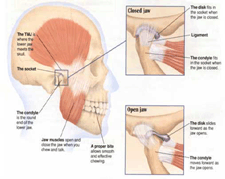المقالات
Occlusion

Mother nature didn't provide all of us with a stable, healthy bite. Some people have bites that have been affected by wear, changed by dental restorations, or that have shifted with time.
A healthy bite allows all of your teeth to hit simultaneously and evenly when your jaw joint is seated into its proper position at the base of your skull. In this position, your chewing muscles are also contracting evenly. One way to test your bite is to shift your jaw to the side. Your canine teeth, or eye teeth, should be the only teeth hitting and should absorb all the lateral biting force.
When you have a bad bite, also called a malocclusion, your teeth do not align properly. This can cause damage to your teeth and restorations, and can also set off a cycle of muscle spasms, pain and soreness commonly referred to as TMD, or temporomandibular disorder.
A malocclusion can also cause a condition called bruxism, which is the clenching or grinding of the teeth that occurs primarily while sleeping. The symptoms of bruxism are worn teeth, notching at the gum line (called abfraction), as well as all of the symptoms associated with TMD.
Abfraction is the notching of teeth near or even under the gum line. When your bite is slightly off, undue stress is placed on the involved teeth and they begin to flex. This continual flexing and stress eventually cause the enamel to separate from the inner dentin layer, forming abfraction's characteristic notch at the gum line.
We can perform a complete bite evaluation, which will help us address any potential problems early in their development. Adjusting, realigning or restoring teeth can prevent many future complications, and can help you gain optimal muscle balance and a comfortable bite.
